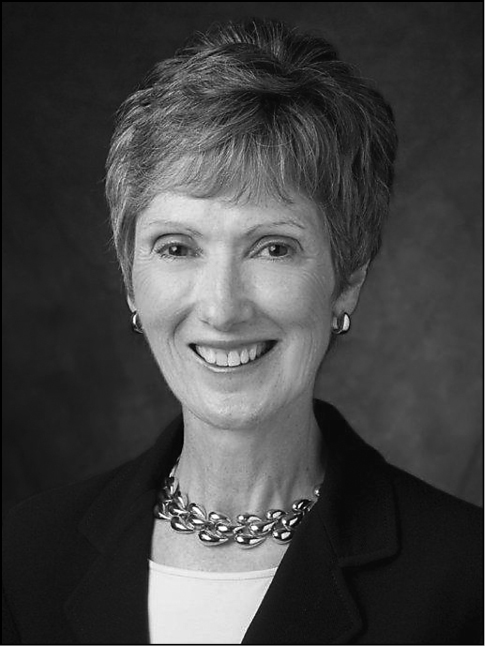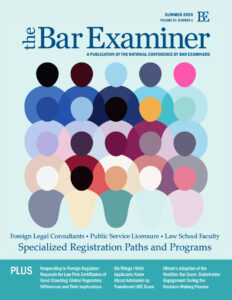This article originally appeared in The Bar Examiner print edition, September 2016 (Vol. 85, No. 3), pp 19–23.
By Diane F. Bosse
There, I’ve said it.” With those words, Erica Moeser, president of the National Conference of Bar Examiners, punctuated her declaration “It is time to reconsider a national bar examination.”
That idea, presented by Erica in the President’s Page of the February 2004 edition of this publication, was not new. It had been percolating among interested constituencies for a few years, but Erica’s (later aptly described as “gutsy”) challenge to bar examiners brought the discussion out of the shadows.
The seeds that germinated into what is now the Uniform Bar Examination (UBE) had first been planted years earlier when another gutsy group—the NCBE Board of Trustees of the early 1970s—imagined that a multiple-choice test of general principles of law in foundational law subjects could fairly assess legal knowledge and analysis in a consistent and efficient way. The Multistate Bar Examination (MBE) was born and, over the intervening years, had gained such acceptance that it was essentially unquestioned that there was a body of knowledge and analytical skills that should reside in the wheelhouse of every new lawyer, wherever he or she sought to practice, and that the MBE reliably measured competence in those domains.
The Idea Begins to Take Hold
In 2002, representatives of the Conference of Chief Justices, the American Bar Association Section of Legal Education and Admissions to the Bar, the Association of American Law Schools, and NCBE came together in a Joint Working Group on Legal Education and Bar Admissions to share knowledge and discuss concerns related to the bar exam and the bar admissions process. The Joint Working Group held a conference in Chicago in 2004 in which candid discussion ensued regarding the purpose, scope, and scoring of bar exams. Much of the discussion centered on the wide variation in passing standards around the country, despite nearly universal reliance on the common instrument of the MBE to determine competence, and concern regarding how such standards were determined. The underlying question was why assessments of minimum competence should diverge so significantly around the country in content and in required passing scores. Participants expressed interest in investigating the possible advantages of a move toward a national licensure system, including the adoption of a national bar exam.
Following the conference, the Bar Admissions Committee of the ABA Section of Legal Education and Admissions to the Bar took up the issue of whether a uniform bar examination was an idea whose time had come, quickly reaching an affirmative conclusion.
Meanwhile, at NCBE, discussions were ongoing, although not in a formalized structure. That structure emerged in 2006 with the appointment of a Special Committee on the Uniform Bar Examination (the “Special Committee”), whose charge was to consider the desirability and feasibility of developing a uniform bar exam and to develop proposed models for such an exam.
Refining the Concept
Worthy of note is the title shift that occurred along the way from Erica’s bold call for consideration of a “national” bar examination to the title the exam has today, the “Uniform” Bar Examination. It was recognized early in the concept development stage that the term “national” bar examination had connotations of centralized control that would be anathema in our federal union of sovereign states. National bar admission was never envisioned, and to call the proposed test a “national” bar exam might convey the erroneous idea that control of bar admissions would be removed from the states. Such was never intended by even the most ardent supporters of a uniform test.
When the Special Committee first met, it was not clear what the UBE would look like, assuming a determination was made that it was an idea worthy of pursuit. There was the possibility that the existing tests offered by NCBE—the MBE, the Multistate Essay Examination (MEE), and the Multistate Performance Test (MPT)—could remain intact, available to those jurisdictions that wished to use some or all of them as part of their bar exams. An entirely new exam might be created for jurisdictions that wanted to be part of a new idea, and all manner of options were on the table, including offering the test in steps, some of which might be taken while examinees were still in law school, and perhaps including new assessments of skills.
The Special Committee quickly determined that the existing battery of tests provided a high-quality assessment mechanism, and no reason was seen to develop something new. A number of jurisdictions were currently using all three tests, providing a ready nucleus of jurisdictions that might be willing to accept the scores achieved on the same tests taken in a sister state.
It was thought that representatives of jurisdictions that were current users of the three tests and of jurisdictions that had expressed some interest in the concept might be willing to engage in a discussion of the feasibility and desirability of adopting a common licensing test, resulting in a score that would be portable. And so representatives of 21 jurisdictions came together in New Orleans in January 2008 to explore the concept. The discussion was ably moderated by Erica and served to highlight good reasons to consider the test as well as the objections and concerns that attended it.
The UBE Takes Shape
From that meeting in New Orleans and prior discussions emerged the broad outlines of a proposed uniform bar examination, which was then presented by the Special Committee to the NCBE Board of Trustees at its meeting in January 2009. The exam would be composed of the existing NCBE multistate tests—the MBE, the MEE, and the MPT—taken in the same administration (i.e., no banking of scores would be permitted), with scaling and combining of scores to be performed by NCBE to ensure consistency in how scores were calculated, and with results reported on a 400-point scale. Grading of the written components would be done locally within the jurisdictions, but all UBE jurisdictions would agree to adhere to the grading guidelines produced by NCBE. Jurisdictions would be free to set their own passing scores but would agree to accept a score achieved in another jurisdiction that met the passing standard of the receiving jurisdiction even if it did not meet the passing standard of the jurisdiction in which the score was achieved. No regrading of examinations would be permitted after scores were released. There would be a committee composed of representatives of user jurisdictions that would consider policies applicable to the UBE and discuss matters of common interest and concern. Jurisdictions would continue to establish educational eligibility standards, make all character and fitness determinations, make decisions regarding test accommodations under the Americans with Disabilities Act, set their own pre-release regrading policies, determine for how long an incoming score would be accepted, and, if desired, require their own state-specific tests or educational components.
The Jurisdictions Climb on Board
The proposal on a uniform bar examination was circulated to the jurisdictions, with interested jurisdictions invited to participate in a forum in Madison, Wisconsin, on June 19–20, 2009. Later that year, jurisdictions that had expressed interest in moving forward with the UBE were invited to a meeting in Phoenix to provide input on its development.
Missouri was the first state to adopt the UBE, doing so in April 2010, amidst tongue-in-cheek inquiries about whether a state could be a Uniform Bar Examination jurisdiction if there was no other state with which to be uniform. North Dakota came to the rescue, adopting the UBE that same year.
Also in 2010, the Special Committee determined that regional adoption might be a natural source of synergy for the UBE, with lawyers living close to state borders presumably having a substantial interest in cross-border admission to enable practice on both sides of the state line. To explore this idea, in 2010 and 2011 the Special Committee hosted three regional informational sessions: in Saratoga Springs, New York, with representatives of 6 northeastern states in attendance; in Salt Lake City, Utah, with 10 western and mountain states participating; and in St. Louis, Missouri, with representatives of the 11 “Big River” states bordering the Mississippi, Ohio, or Missouri River joining for discussion.
Word was spreading, and the value of the UBE was acknowledged with the adoption in 2010 of resolutions by the Conference of Chief Justices and the Council of the ABA Section of Legal Education and Admissions to the Bar endorsing consideration by the jurisdictions of adopting the UBE.1
In February 2011, the first administration of the UBE occurred in Missouri and North Dakota, with Alabama joining in offering the exam in July. In 2011—in addition to Alabama—Washington, Idaho, Colorado, and Arizona adopted the UBE, followed in 2012 by Nebraska, Utah, Montana, and Wyoming. New Hampshire, Minnesota, and Alaska were next in 2013, followed in early 2015 by Kansas, bringing to 15 the total number of states adopting the UBE.
Despite the fact that the jurisdictions that had adopted the UBE included jurisdictions with major metropolitan areas—Denver, Kansas City, Minneapolis, Phoenix, and Seattle among them—there was in those years a persistent view that the UBE was a good idea for small states, and less so for the larger jurisdictions. That all changed in May 2015 when then–Chief Judge Jonathan Lippman of the New York Court of Appeals announced that New York would adopt the UBE effective with the July 2016 administration of the exam.
New York’s announcement had been preceded by a months-long study by an Advisory Committee appointed by Chief Judge Lippman to examine a proposal to adopt the UBE. After conducting public hearings and accepting written comments, the Advisory Committee issued a report2 recommending adoption of the UBE, and addressing criticisms and concerns raised in New York, which may also be matters of concern in other jurisdictions as they consider the UBE.
New York’s adoption of the UBE was followed by Iowa, Vermont, and New Mexico in 2015, and by South Carolina, the District of Columbia, New Jersey, West Virginia, Connecticut, and Massachusetts in 2016, bringing to 25 the total number of UBE jurisdictions as of the date of this writing.
Addressing Criticisms and Concerns
The concept of an exam that produces a portable score has had its critics. First, there are those who believe that demonstrating competence in general principles is necessary but insufficient, as competence in state law and local procedure is critical to effective practice. Some jurisdictions have addressed that concern by requiring a state-specific test or educational component to assess knowledge of state-specific law, as described in articles appearing elsewhere in this publication.3
Also raised have been parochial concerns about the influx of large numbers of new lawyers taking jobs away from the local bar. Of course, the purpose of the bar exam is to protect the public by admitting to practice only those candidates who have acquired the quantum of knowledge and skill that equates to minimum competence, not to protect the economic fortunes of the practicing bar or local law students. The argument also ignores the upside for those who might seek to relocate for employment or family reasons, for lawyers engaged in cross-border representation of clients, for clients with legal problems that cross state lines, and for law firms seeking associates admitted in multiple jurisdictions. To date, the number of UBE score transfers has been comparatively small4 but growing, and score portability has been enormously significant for those who have benefitted from the ability to move to another state without the necessity of taking another bar examination (and, in some cases, exactly the same components), with its attendant cost, delay, and anxiety.
Important concerns have been raised in several jurisdictions about the impact of adoption of the UBE on diversity in our profession. The short but not wholly satisfactory answer is that the impact cannot be known without adopting the UBE. That is, no jurisdiction will ever be administering the UBE and its traditional bar examination to the same cohort of test takers, such that an apples-to-apples comparison can be made. And it is unquestioned that test populations can vary significantly from year to year in their performance on the bar exam, as is evidenced by recent results in several jurisdictions, with passing rates varying from one year to the next in sometimes dramatic ways.
Although the important question of the differential performance of racial, ethnic, and gender subgroups of examinee populations on the UBE as compared to the traditional bar exam cannot be answered with certainty, New York’s Advisory Committee found that the available evidence provided no reason to believe that any demographic group would be advantaged or disadvantaged by taking the UBE as opposed to the traditional bar exam.5 With no available evidence to suggest a differential impact, New York found no reason not to adopt the UBE, but sufficient reason to study the issue in the early years of administration of the UBE.6
Loss of local control of the bar exam is another concern that has been frequently raised as jurisdictions around the country consider whether to adopt the UBE. This concern has been ameliorated to a significant degree by ongoing participation in the consideration of policy issues related to the exam in regular gatherings of UBE jurisdictions. The jurisdictions that have adopted the UBE have entered a compact to administer and grade the exam in a uniform fashion and to respect the judgment of their sister states in the results. This continuing voice regarding the content and administration of the UBE and related policy issues, and the ongoing opportunity to engage in discussion with sister jurisdictions of the issues attendant to a common licensing test, have given confidence to the jurisdictions that they have an important role to play in shaping the future of the UBE.
Where We Are Today
In February 2016, the ABA House of Delegates, at the urging of the ABA Law Student Division—and with the support of NCBE; the ABA Section of Legal Education and Admissions to the Bar; and the ABA Law Practice Division, Tort Trial and Insurance Practice Section, and Senior Lawyers Division—adopted a resolution urging all jurisdictions to “adopt expeditiously the Uniform Bar Examination.”7
Also in February 2016, the Conference of Chief Justices adopted a similar resolution urging all states to “consider implementation of the Uniform Bar Examination.”8
Based on 2015 numbers for the 25 jurisdictions that have now adopted the UBE, by July 2018 (which will be the first administration of the UBE in Massachusetts, the latest jurisdiction to adopt the UBE), if no additional jurisdiction signs on (an unlikely circumstance), there will be an approximate total of 31,830 examinees taking the UBE annually. That represents a 16-fold increase from the total number of examinees in the first year of UBE administration and over 41 percent of all examinees, based upon 2015 numbers.9
In his book of the same name,10 Malcolm Gladwell defines the tipping point as the moment of critical mass. It appears the UBE has crossed that threshold!
Notes
- Conference of Chief Justices, Resolution 4, Endorsing Consideration of a Uniform Bar Examination, http://ccj.ncsc.org/~/media/microsites/files/ccj/resolutions/07252012-endorsing-consideration-of-a-uniform-bar-examination.ashx; ABA Section of Legal Education and Admissions to the Bar, Council Resolution, Endorsing Consideration of a Uniform Bar Examination, http://www.abajournal.com/files/Uniform_Bar_Exam_2010_Council_(9-14)_v2.pdf. (Go back)
- Advisory Committee on the Uniform Bar Examination, Ensuring Standards and Increasing Opportunities for the Next Generation of New York Attorneys, Final Report to Chief Judge Jonathan Lippman and to the Court of Appeals, April 2015, http://www.nycourts.gov/ip/bar-exam/pdf/FINAL%20REPORT_DRAFT_April_28.pdf. (Go back)
- [Editor’s Note: See this issue’s section devoted to describing the jurisdiction-specific components that have been developed by UBE jurisdictions.] (Go back)
- As of August 31, 2016, a total of 29,544 UBE scores have been earned, and 3,308 UBE scores transferred, since the first UBE administration in February 2011. (This does not include scores earned and transferred for the July 2016 exam administration, for which data are not yet available.) (See this issue’s data on UBE scores earned and transferred by exam date.) (Go back)
- Supra note 2, at 53–61.(Go back)
- Id., at 61–62.(Go back)
- American Bar Association, House of Delegates Resolutions, Resolution 109, available at http://www.americanbar.org/news/reporter_resources/midyear-meeting-2016/house-of-delegates-resolutions/109.html (last visited 26 July 2016). (Go back)
- Conference of Chief Justices, Resolution 10, Urging Consideration of Implementation of Uniform Bar Examination, http://ccj.ncsc.org/~/media/microsites/files/ccj/resolutions/02012016-urging-consideration-implementation-uniform-bar-examination.ashx. (Go back)
- 2015 Statistics, 85(1) The Bar Examiner 14–49 (March 2016), at 16–17; 2011 Statistics, 81(1) The Bar Examiner 6–41 (March 2012), at 8–9. (Go back)
- Malcolm Gladwell, The Tipping Point (Back Bay Books 2002). (Go back)
 Diane F. Bosse is chair of the New York State Board of Law Examiners. She is a former chair of the NCBE Board of Trustees and a member of NCBE’s Special Committee on the Uniform Bar Examination. A graduate of the State University of New York at Buffalo, Bosse is of counsel to the Buffalo law firm of Hurwitz & Fine PC.
Diane F. Bosse is chair of the New York State Board of Law Examiners. She is a former chair of the NCBE Board of Trustees and a member of NCBE’s Special Committee on the Uniform Bar Examination. A graduate of the State University of New York at Buffalo, Bosse is of counsel to the Buffalo law firm of Hurwitz & Fine PC.
Contact us to request a pdf file of the original article as it appeared in the print edition.







